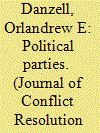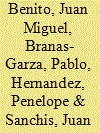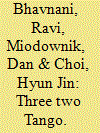|
|
|
Sort Order |
|
|
|
Items / Page
|
|
|
|
|
|
|
| Srl | Item |
| 1 |
ID:
101855


|
|
|
|
|
| Publication |
2011.
|
| Summary/Abstract |
This article examines how different components of globalization affect the death toll from internal armed conflict. Conventional wisdom once held that the severity of internal conflict would gradually decline with the spread of globalization, but fatalities still remain high. Moreover, leading theories of civil war sharply disagree about how different aspects of globalization might affect the severity of ethnic and nonethnic armed conflicts. Using arguments from a variety of social science perspectives on globalization, civil war, and ethnic conflict to guide the analysis, this article finds that (1) economic globalization and cultural globalization significantly increase fatalities from ethnic conflicts, supporting arguments from ethnic competition and world-polity perspectives, (2) sociotechnical aspects of globalization increase deaths from ethnic conflict but decrease deaths from nonethnic conflict, and (3) regime corruption increases fatalities from nonethnic conflict, which supports explanations suggesting that the severity of civil war is greater in weak and corrupt states.
|
|
|
|
|
|
|
|
|
|
|
|
|
|
|
|
| 2 |
ID:
101856


|
|
|
|
|
| Publication |
2011.
|
| Summary/Abstract |
Does a state's past win/loss record affect its subsequent choices of peaceful dispute resolution methods in territorial disputes? We present a theory that portrays attempts at peaceful resolution as a strategic process, by which states search for the most favorable forum. During the process of decision making, a state strategically chooses between several methods of peaceful resolution; its final choice is based on the state's past experience with this particular method. Empirical analysis of all attempts at peaceful resolution of territorial disputes from 1945 to 2003 shows that challenger states use their own record of victories and failures, as well as the win/ loss record of the target as indicators of the probability of winning in a subsequent dispute. This pattern is especially strong for the binding third-party methods, arbitration, and adjudication.
|
|
|
|
|
|
|
|
|
|
|
|
|
|
|
|
| 3 |
ID:
101858


|
|
|
|
|
| Publication |
2011.
|
| Summary/Abstract |
The purpose of this article is to explain the creation of terrorist organizations by political parties. Extant literature argues that institutional structural constraints, such as electoral systems, are more likely to lead political parties to create terrorist organizations. However, this article hypothesizes that party ideology is also an important factor that explains the creation of terrorist organizations by political parties. Using a Poisson random effect model for panel data on twenty-eight countries between 1965 and 2003, this article shows that party ideology is positively correlated with the formation of terrorist organizations even after controlling for institutional structural constraints. The implication of these findings is important for policy makers eager to create stable polities.
|
|
|
|
|
|
|
|
|
|
|
|
|
|
|
|
| 4 |
ID:
101859


|
|
|
|
|
| Publication |
2011.
|
| Summary/Abstract |
Poverty is often identified as a determinant of terrorist group participation, but existing research reveals mixed support for this relationship. Some studies find that macroeconomic decline is associated with increased production of terrorists, but micro-level research suggests terrorists have above average socioeconomic status and educational attainment. In this article, the author argues that poverty should increase terrorist group participation only for individuals with high education. The author suggests that as a result of terrorist group selection preferences and the lower opportunity costs for militant group membership in economically depressed environments, the likelihood of terrorist group participation should be highest for the highly educated, poor members of any population. The author tests the hypotheses using data from Krueger and Maleckova (2003) on participation in Hezbollah, adding an interaction term to their model. The results support the hypotheses. Poverty increases the likelihood of participation in Hezbollah only for those with at least high school education.
|
|
|
|
|
|
|
|
|
|
|
|
|
|
|
|
| 5 |
ID:
101857


|
|
|
|
|
| Publication |
2011.
|
| Summary/Abstract |
This article shows the results of experiments where subjects play the Schelling's spatial proximity model. Two types of experiments are conducted: one in which choices are made sequentially and a variation of the first where the decision making is simultaneous. The results of the sequential experiments are identical to Schelling's prediction: subjects finish in a segregated equilibrium. Likewise, in the variant of the simultaneous decision experiment, the same result is reached: segregation. Subjects' heterogeneity generates a series of focal points in the first round. To locate themselves, subjects use these focal points immediately, and as a result, the segregation takes place again. Furthermore, simultaneous experiments with commuting costs allow us to conclude that introducing positive moving costs does not affect segregation.
|
|
|
|
|
|
|
|
|
|
|
|
|
|
|
|
| 6 |
ID:
101860


|
|
|
|
|
| Publication |
2011.
|
| Summary/Abstract |
This article extends the formal logic of Stathis Kalyvas' theory of selective violence to account for three political actors with asymmetric capabilities. In contrast to Kalyvas' theory, the authors' computer simulation suggests that (1) selective violence by the stronger actor will be concentrated in areas where weaker actors exercise control; (2) the relative level of selective violence used by weaker actors will be lower because of a reduced capacity to induce civilian collaboration; and (3) areas of parity among the three actors will exhibit low levels of selective violence perpetrated primarily by the strongest actor. Results from a logistic regression, using empirical data on Israel and two rival Palestinian factions from 2006 to 2008, are consistent with these predictions: Israel was more likely to use selective violence in areas largely controlled by Palestinian factions; zones of incomplete Israeli control were not prone to selective violence; and zones of mixed control witnessed moderate levels of selective violence, mainly by Israel. Nonetheless, Palestinian violence remained consistent with Kalyvas' predictions.
|
|
|
|
|
|
|
|
|
|
|
|
|
|
|
|
|
|
|
|
|